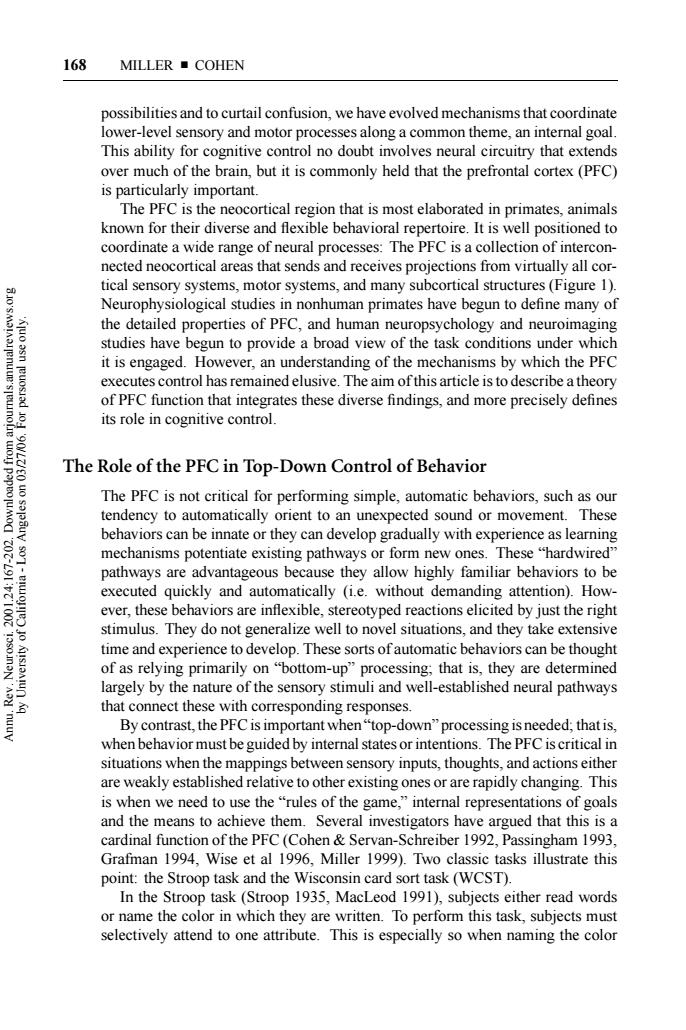正在加载图片...

168 MILLER■COHEN possibilities and to curtail confusion,we have evolved mechanisms that coordinate ower-level sensory and motor processes along a common theme,an internal goal This ability for cognitive control no doubt involves neural circuitry that extends over much of the brain,but it is commonly held that the prefrontal cortex(PFC) ymportant that is most elaborated in primates,animals known for thei coordinate a wide range of neural processes:The PFC is a collection of intercon nected neocortical areas that sends and receives projections from virtually all cor tical sensory systems,motor systems,and many subcortical structures(Figure 1). Neurophysiological studies in nonhuman primates have begun to define many of the detailed properties of PFC,and hu neuropsyc ogy and neuroimaging studies have begun to provide a broad view of the task conditions under which it is engaged.However,an understanding of the mechanisms by which the PFC executes control has remained elusive.The aim ofthis article is to describe a theory of PFC function that integrates these diverse findings,and more precisely defines its role in cognitive control. The Role of the PFC in Top-Down Control of Behavior The PFC is not critical for performing simple,automatic behaviors,such as our mechanisms potentiate existing pathw ays or form ne ones "hardwired pathways are advantageous because they allow highly familiar behaviors to be executed quickly and automatically (i.e.without demanding attention).How- ever,these behaviors are inflexible,stereotyped reactions elicited by just the right stimulus.They do not generalize well to novel situations,and they take extensi time and experience to develop.These sorts ofauto omatic behaviors can be though of as relying primarily on"bottom-up"processing;that is,they are determined largely by the nature of the sensory stimuli and well-established neural pathways that connect these with corresponding responses. By contrast,the PFC is important when"top-down"processing is needed:that is when behaviormust be guided by internal statesor intentions.The PFCiscritical in situations when veen sensory inputs,thoughts and actionseithe re weakly established relative to other existing ones or are rapidly chan is when we need to use the "rules of the game,"internal representations of goals and the means to achieve them.Several investigators have argued that this is a cardinal function of the PFC(Cohen Servan-Schreiber 1992 Passingham 1993 Grafman 1994.Wise et al 1996,Miller 1999).Two classic tasks illustrate this point:the Stroop task k and the Wisconsin card sort task(WCST) In the Stroop task(Stroop 1935,MacLeod 1991),subjects either read words or name the color in which they are written.To perform this task,subjects must selectively attend to one attribute.This is especially so when naming the colorP1: FXZ January 12, 2001 14:38 Annual Reviews AR121-07 168 MILLER ¥ COHEN possibilities and to curtail confusion, we have evolved mechanisms that coordinate lower-level sensory and motor processes along a common theme, an internal goal. This ability for cognitive control no doubt involves neural circuitry that extends over much of the brain, but it is commonly held that the prefrontal cortex (PFC) is particularly important. The PFC is the neocortical region that is most elaborated in primates, animals known for their diverse and flexible behavioral repertoire. It is well positioned to coordinate a wide range of neural processes: The PFC is a collection of interconnected neocortical areas that sends and receives projections from virtually all cortical sensory systems, motor systems, and many subcortical structures (Figure 1). Neurophysiological studies in nonhuman primates have begun to define many of the detailed properties of PFC, and human neuropsychology and neuroimaging studies have begun to provide a broad view of the task conditions under which it is engaged. However, an understanding of the mechanisms by which the PFC executes control has remained elusive. The aim of this article is to describe a theory of PFC function that integrates these diverse findings, and more precisely defines its role in cognitive control. The Role of the PFC in Top-Down Control of Behavior The PFC is not critical for performing simple, automatic behaviors, such as our tendency to automatically orient to an unexpected sound or movement. These behaviors can be innate or they can develop gradually with experience as learning mechanisms potentiate existing pathways or form new ones. These “hardwired” pathways are advantageous because they allow highly familiar behaviors to be executed quickly and automatically (i.e. without demanding attention). However, these behaviors are inflexible, stereotyped reactions elicited by just the right stimulus. They do not generalize well to novel situations, and they take extensive time and experience to develop. These sorts of automatic behaviors can be thought of as relying primarily on “bottom-up” processing; that is, they are determined largely by the nature of the sensory stimuli and well-established neural pathways that connect these with corresponding responses. By contrast, the PFC is important when “top-down” processing is needed; that is, when behavior must be guided by internal states or intentions. The PFC is critical in situations when the mappings between sensory inputs, thoughts, and actions either are weakly established relative to other existing ones or are rapidly changing. This is when we need to use the “rules of the game,” internal representations of goals and the means to achieve them. Several investigators have argued that this is a cardinal function of the PFC (Cohen & Servan-Schreiber 1992, Passingham 1993, Grafman 1994, Wise et al 1996, Miller 1999). Two classic tasks illustrate this point: the Stroop task and the Wisconsin card sort task (WCST). In the Stroop task (Stroop 1935, MacLeod 1991), subjects either read words or name the color in which they are written. To perform this task, subjects must selectively attend to one attribute. This is especially so when naming the color Annu. Rev. Neurosci. 2001.24:167-202. Downloaded from arjournals.annualreviews.org by University of California - Los Angeles on 03/27/06. For personal use only